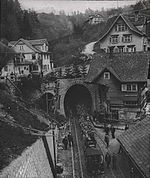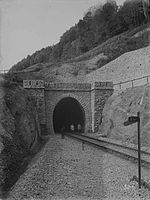Water flow tunnel
| Water flow tunnel | ||
|---|---|---|
|
Voralpenexpress with SOB Re 456 when driving out of the Wasserfluhtunnel in Lichtensteig
|
||
| use | Railway tunnel | |
| traffic connection | St. Gallen – Wattwil | |
| place | Brunnadern , Lichtensteig | |
| length | 3556 m | |
| Number of tubes | 1 | |
| construction | ||
| building-costs | 1.3 million CHF | |
| start of building | December 27, 1905 | |
| completion | May 6, 1910 | |
| business | ||
| operator | SOB | |
| location | ||
|
|
||
| Coordinates | ||
| Brunnadern east portal | 727805 / 244106 | |
| West portal Lichtensteig | 724699 / 242518 | |
The Wasserfluhtunnel is a 3.5 km long single-lane Swiss railway tunnel on the St. Gallen – Wattwil railway line between Brunnadern and Lichtensteig .
description

The 3,556-meter-long Wasserfluhtunnel was built between 1905 and 1910 by the then Bodensee-Toggenburg Railway (BT). It leads under the Wasserfluhpass and connects the Neckertal with the Thur valley . The structure is the longest tunnel of its current owner, the Swiss Southeast Railway (SOB), and has a constant gradient of 10.4 ‰ towards the west portal in Lichtensteig. The first 428 meters after exiting the Brunnadern-Neckertal station are in a curve of 400 meters radius, the following 3128 meters are in a straight line. Immediately after the west portal there is a 39 meter long pre-tunnel that crosses under the canton road (tunnel under the canton road).
A water pipe runs through the tunnel, which supplies the town of Lichtensteig with drinking water from the Neckertal.
construction
On December 27, 1905, the Bodensee-Toggenburg-Bahn (BT) began directing the preparatory work for the construction of Wasserfluhtunnels. In February 1906, the propulsion of was from both sides soles tunnel added. The miners worked with hand-operated drills and came across Nagelfluh and thin layers of marl .
From May 1, 1906, the Favetto & Catello company from Brunnen took over the construction work and switched to mechanical drilling on the west side. The electrical power for operating the pneumatic ram drilling machines came from the Kubel power station . The excavated material served to fill in the station areas Brunnadern-Neckertal and Lichtensteig. The construction work was progressing very slowly because the company was affected by organizational and financial difficulties. After much back and forth, the construction company decided to use the ridge slot method to widen the tunnel profile. The predominantly Italian construction workers were dissatisfied with the working conditions and stopped working on June 27, 1907. They called for more wages and a reduction in daily working hours from ten to eight hours. The construction company partially complied with the demands and the strike ended on July 19, 1907.
Due to the delayed construction progress, the Bodensee-Toggenburg-Bahn withdrew the contract from the construction company on June 19, 1908 and carried out the work on its own again. BT hired more staff and invested in workshops, installations and rolling stock. The backlog could be made up and on April 2, 1909, the bottom tunnel was breached. On May 6, 1910, the tunnel vault was completely lined.
The construction claimed numerous victims. Seven people lost their lives in the construction work, 25 were permanently disabled.
East portal not far from the Brunnadern station. The tendency pointer right in the picture signals the transition from the horizontal-station equipment for gradient of 10.4 ‰ in the tunnel.
Operation and modifications

On October 3, 1910, the St. Gallen – Wattwil line was opened with the water flow tunnel. The line has been operated electrically since October 4, 1931. In the 1980s and 1990s, from the two tunnel portals, shotcrete was applied to the tunnel vault over a length of 90 and 230 meters, respectively , in order to prevent seepage water from draining . This prevented the formation of icicles that protruded into the clearance profile .
In December 2007 a fiber optic cable was pulled through the tunnel, which is used by SOB and Thurwerke AG. It supplies the Neckertal with cable TV and internet . In 2011 and 2012, the SOB extensively renovated the water flow tunnel. Damaged masonry stones and joints in the vault were repaired and water inlets were taken. To enable double-decker trains to pass through, the SOB replaced the overhead contact line with a conductor rail and lowered the tunnel floor by 10 to 40 cm over a third of the tunnel length. To improve safety, a tunnel radio system , a handrail with emergency lighting and emergency call facilities were installed in the personal protection niches.
swell
- Gerhard Oswald: The Bodensee-Toggenburg Railway . Appenzeller Verlag, Herisau 2004, ISBN 978-3-85882-361-8 .
- Günther Fässler: Wasserflhtunnel: a bottleneck is being renewed . In: TEC21 . Volume 138 (2012), Issue Dossier on the conservation of the SOB route (archived in E-Periodica of the ETH Library , PDF; 1.8 MB).
- The Bodensee-Toggenburg Railway (end) In: Schweizerische Bauzeitung . Volume 49 (1907), issue 24 (archived in E-Periodica of the ETH-Bibliothek, PDF; 5.1 MB).
Web links
Notes and individual references
- ↑ Sabine Schmid: Cooperation is getting closer. In: St. Galler Tagblatt. July 7, 2011, accessed January 1, 2016 .
- ↑ a b On the construction of the Bodensee-Toggenburg Railway In: Schweizerische Bauzeitung . Volume 60 (1912), Issue 13 (archived in E-Periodica of the ETH-Bibliothek , PDF; 5.4 MB).
- ^ Peter Müller: Italiani, tuemmer streigge! In: rails, gravel, sweat. 100 years of Romanshorn – Wattwil. Strings. Ostschweizer Kulturmagazin, October 2010, accessed on January 1, 2016 .
- ^ Hans G. Wägli: Swiss rail network and Swiss rail profile CH + . AS Verlag, Zurich 2010, ISBN 978-3-909111-74-9 .
- ↑ Energy, water and communication supply company active in the Wattwil area and in Neckertal
- ↑ Toni Hässig: Cable blown through the tunnel. In: St. Galler Tagblatt. December 14, 2007, archived from the original on January 27, 2016 ; accessed on January 1, 2016 .
- ↑ Tunnel with radio and emergency evacuation. In: St. Galler Tagblatt. March 6, 2013, accessed on January 1, 2016 (according to a media release by the SOB).







